Microsoft Surface 2 Review
by Anand Lal Shimpi on October 21, 2013 12:00 AM ESTSoC, CPU & Performance
At the heart of Microsoft’s Surface 2 is a quad-core NVIDIA Tegra 4 SoC. That’s four usable ARM Cortex A15 cores running at up to 1.7GHz (1.9GHz with only a single core active), behind a shared 2MB L2 cache. You also get NVIDIA’s most powerful ultra mobile GPU to-date, a 72-core implementation of its ultra low power GeForce architecture. The combination of the two gives Microsoft a much better platform than the original Surface RT device.
The difference is immediately apparent. While Surface RT felt slow, Surface 2 feels fast enough for most light workloads. Typing in Word now typically consumes < 20% of all available cores/CPU cycles, compared to 20 – 40% on last year’s Tegra 3 based model. I can still get CPU utilization as high as 50% by pounding on as many keys as fast as possible, but that’s the exception not the rule.
If you remember back to my first Surface RT review I talked about how I could sometimes type quicker than the system would be able to process and display my text. I’m happy to say that’s no longer an issue, although I’m not sure how much of it is software vs. hardware improvements. Needless to say that for general Office work, Surface 2 is a much better device than its predecessor.
Application launch times are also a bit better compared to Surface RT at launch. Some apps still take longer to initialize than their equivalents under Android or iOS, but the improvements over the past year have been significant. Applications that used to take 5 – 7 seconds to launch now take 2 – 4 seconds. That’s compared to the < 2 seconds for most of the core apps on iOS, but it’s movement in the right direction at least.
On the CPU side we don’t have a ton of great performance tests to let us compare platforms (not yet at least), but we do have our standard suite of js benchmarks. Since we’re dealing with Windows RT, the only browser option is Internet Explorer 11 – which is both a blessing and a curse depending on what benchmark you’re looking at.
I’ll start with SunSpider since that appears to be the best case for IE11. Here we see just how much software can influence the overall performance of these browser based benchmarks.
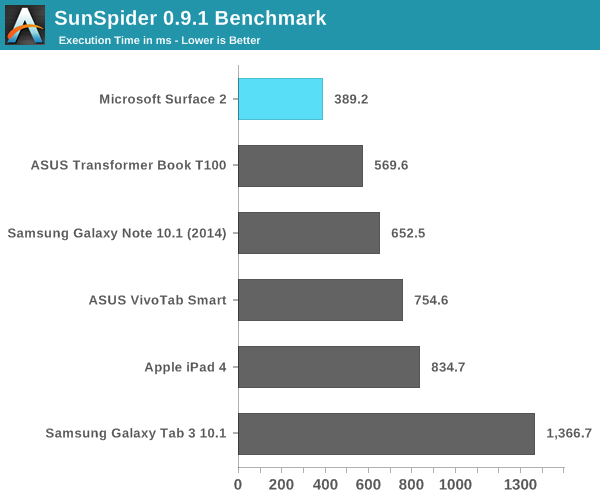
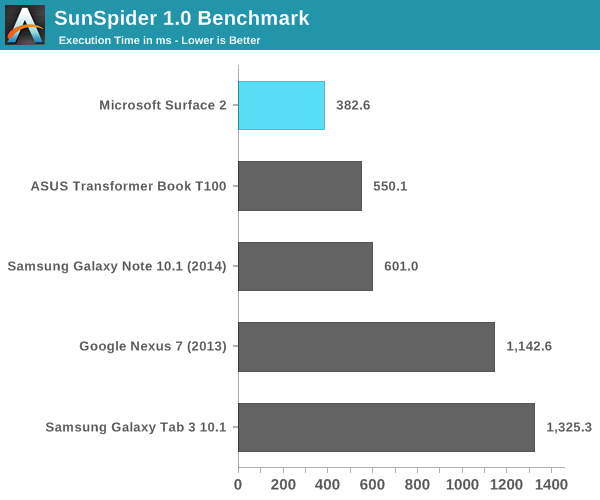
Tegra 4 running IE11 posts a better SunSpider score than even the A7 based iPhone 5s. Looking at the rest of the tests it’s very clear that SunSpider was an optimization target for Microsoft, as we don’t see this sort of performance leadership repeated anywhere else.
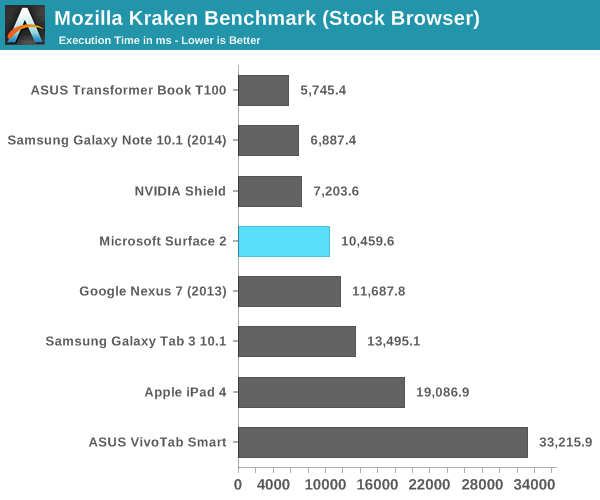
The Kraken results look decent but clearly behind high-end Android devices running Chrome. This is a huge improvement over where Microsoft was last year with Surface RT. Surface 2 can now complete the Kraken test in roughly 1/5 of the time it took Surface 1/RT to do the same work at launch. Obviously we’re seeing the benefits of IE11 in addition to Windows RT 8.1 being better optimized for ARM architectures (as well as a faster SoC), but the new tablet is just significantly faster than its predecessor.

Browsermark 2.0 gives us a good idea of where Surface 2 falls in terms of overall browsing performance. In general we’re dealing with a platform that is roughly comparable in performance to modern Android devices, but it’s not pushing the limits of performance in any way.

Google’s Octane test is obviously best optimized for Chrome, and here we see solid performance although clearly behind the fastest Android and Bay Trail devices.
GPU Performance
All of the Windows RT devices that launched last year had pretty terrible GPU performance. It didn’t matter if you had something with NVIDIA or Qualcomm inside, GPU performance wasn’t great at all. Even Intel’s competing Clover Trail solution was a huge let down on the GPU front. Clover Trail was so bad that I even noticed differences in animation frame rate between the Atom Z2560 and Qualcomm’s APQ8060A running Windows RT.
Tegra 4’s GPU on the other hand seems well suited for the task at hand. I doubt many users will be playing 3D games on Surface 2, but GPU performance is improved substantially over its predecessor. In the grand scheme of things we’re talking about roughly iPad 4 class GPU performance, all while driving a lower resolution screen.
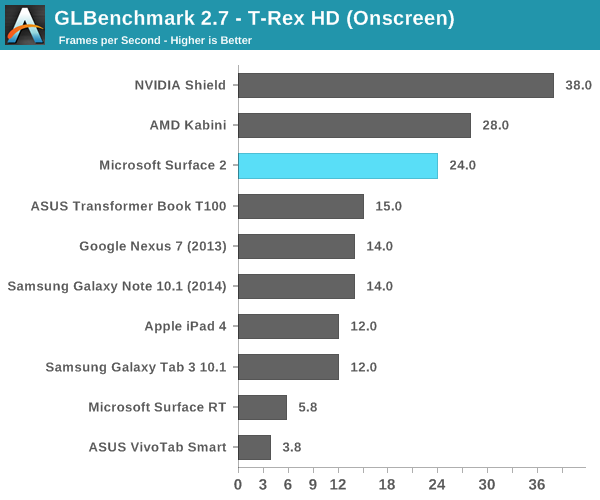
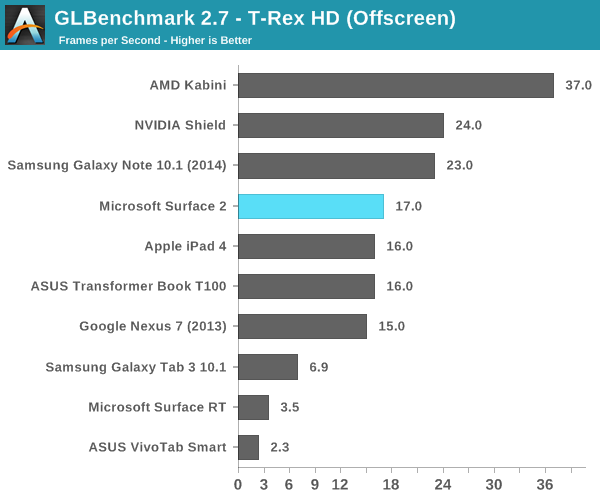
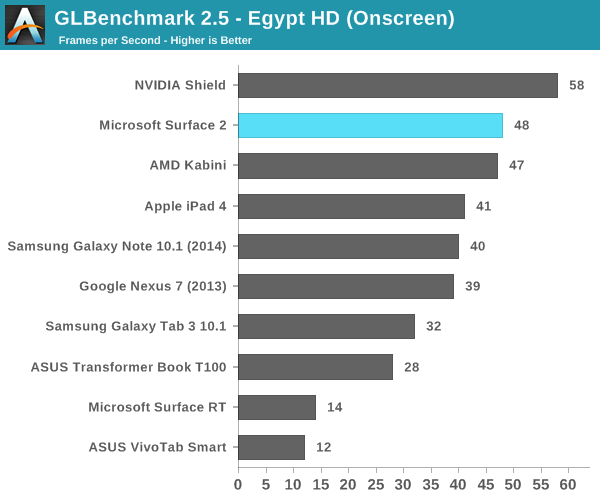
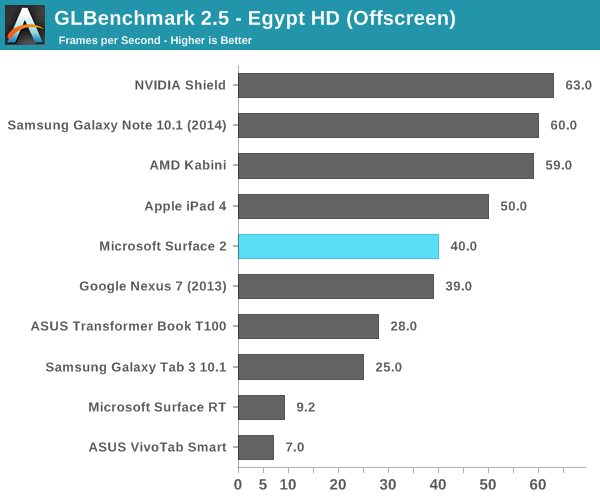



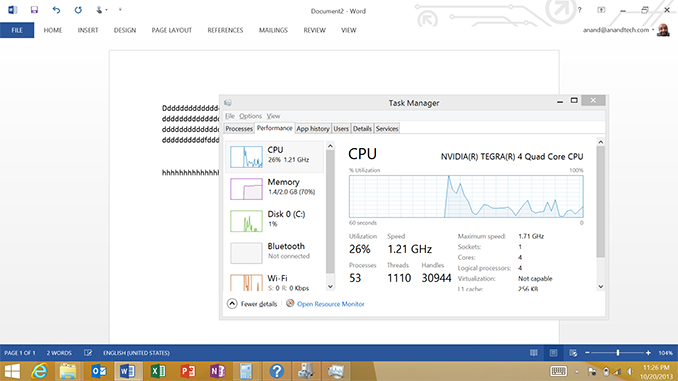








139 Comments
View All Comments
Da W - Monday, October 21, 2013 - link
1- I use both MS and Google services on my surface (pro) and android phone (and dropbox). I do prefer MS bundle overall. I find also that its a generation thing, most aged 30-40Y tend to prefer MS while the younger generation tend to hate MS (and choose Google).2- Every google services, facebook, twiter, most "apps" are accessible in their internet version via ie11 and pinable on the start screen. In fact i think the lack of apps on the Windows store is a non-issue. On my android phone, i use mostly apps and almost never use the chrome browser. On my surface it's the opposite, i use almost no apps and do everything i need in the browser. (working in the browser is also the point of google chrome, so it's not a bas thing).
I think the # of app issue is overrated.
3- Agreed you can put Windows RT in the same class as google chrome, functionnality wise. That is: a limited OS that can't do what other mature OSes can.
Wolfpup - Thursday, October 31, 2013 - link
It is kind of Microsoft's version of a Chromebook, BUT it still does more. It still has local programs (even if you can only get them through the store). It still has much more of a real file system and has printer (and I think even scanner now?) support, etc.RannXeroxx - Friday, November 29, 2013 - link
Actually I think you have it wrong. Its people in their late 20s or mid 30s that seem to hate MS but younger people, just like they don't connect to the cold war or the fear of the USSR, they don't connect with the Microsoft Monopoly of the 90's and think of MS as XBox and WP8.prophet001 - Monday, October 21, 2013 - link
Good post sri_tech.hoboville - Monday, October 21, 2013 - link
Sorry, but that's an apples and oranges comparison. Chrome vs. Windows isn't the issue. It's Windows RT vs. Windows x86. With RT you get a gimped version of Windows that relies on the M$ Store for apps if you go with RT. If you go with Pro, you pay out the face for a device that is simply a super light, small touch-screened laptop. The great thing about Windows was that it could run a bajillion different x86 programs...not with RT though.Ok, so I'll pay $800 for a Pro? For $700, you can get a Haswell laptop with full x86 features (not gimped ARM derpness) on the Windows platform. You'll get the same battery life, a bigger screen, more storage space, the ability to upgrade, and more RAM. Don't forget the fact it has a real keyboard.
As Anand said: "When we first posted about ASUS’ T100, common feedback was that users would be willing to pay more for an even better device. A Bay Trail Surface 2 could’ve been that device." That's exactly my point, the RT could have waited 3-4 months ditched Tegra and gone to Bay Trail, which is extremely efficient, more powerful, and is x86. For $500 a full x86 tablet with Windows 8 would be a bombshell. It would have most of the features of a laptop while being a tablet. However, M$ is more concerned about roping people in to the M$ Store where they can cash out on apps BECAUSE the RT is a closed platform. They want you to get RT because it means they can milk you for most cash. If you want x86 they will charge you out the wazoo because they know once there, you can use any program you want.
trip1ex - Monday, October 21, 2013 - link
I don't think people want Windows x86 tablets. I think people want to ditch Windows. :)kyuu - Monday, October 21, 2013 - link
You're confusing "people" with "you".Why should I (or people) want to ditch Windows? What does iOS or Android offer that Windows doesn't? As far as I can tell it's nothing but a regression in features either way. OSX? I've used it and had the option for years. Still not interested. Linux? I can see the appeal, but again, I've used it and had the option for years. Nothing has changed that makes it more appealing than Windows for me or your average user.
ChromeOS? Don't make me laugh.
You want to avoid the malware situation that ignorant users get into on their Windows machines? Windows RT works for that. People who need more out of their OS than WinRT gives them should know enough to avoid malware in the first place.
Hrel - Friday, October 25, 2013 - link
He didn't say google apps were better, he said it depends on which apps you prefer.theduckofdeath - Wednesday, October 30, 2013 - link
Chrome OS does support touch screens. The Pixel has a touch ditto.And just because Microsoft has services, it is not unanimous with them being of equal quality. Personally, I find Google Docs to be more accessible despite the obvious lack of many features. There's no point in having an advanced online Office service, if it's not as simple to use.
thebeastie - Monday, October 21, 2013 - link
Looks pretty decent, I would feel good about recommending this to my clueless relatives who click and install every single web ad that pops up saying its going to "Improve system performance by %300" and installs garbage and maybe even something that attempts to rob them blind.With RT OS I feel assured that won't happen and they can sit and doodle in Office all day and be safe.